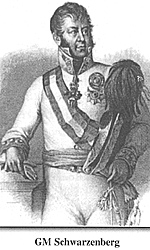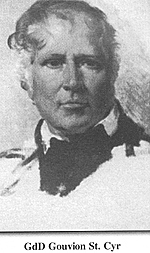Battle of Stockach
25 March 1799
Part 1
March 24th -- First Clashes
by Roland Kessinger, Germany
| |
During the morning of the 24th, the Austrian advance guard pushed forward along three axes: GM Schwarzenberg followed the Stockach-Singen road; GMs Gyulai and Kienmayer, reinforced by part of GM Piacek’s brigade advanced from Aach to Engen, and GM Merveldt tried to reach Liptingen and Neuhausen ob Eck marching west from Schwandorf. Jourdan had decided to end his retreat that day, so there were several clashes between the Austrian advance guard and some of the French units between Singen and Liptingen. During the day, units from the Austrian main body could be used to reinforce their advance guards, as the main body had advanced from Pfullendorf to a new camp near Stockach in two columns. Ferino against Schwarzenberg GM Schwarzenberg’s brigade formed the head of the Austrian left wing and soon reached Steisslingen. From there, he drove the French outposts back behind Friedingen village (not to be confused with Fridingen on the Danube) and evicted Ferino’s advance guard from the forest between Friedingen and Singen. In response, Ferino sent forward Tharreau’s brigade, which forced Schwarzenberg’s troops to withdraw. Meanwhile, during the afternoon, the main Austrian army had reached its new positions at Stockach. Schwarzenberg was reinforced with IR3 Erzherzog Karl and in the late afternoon, he reoccupied the forest between Friedingen and Singen, so that as night fell, Schwarzenberg was holding his lines in front of Friedingen on the Stockach-Singen road. Facing him were Ferino’s 1st Division, whose right brigade was still concentrated near Singen, while the left was further to the north between Singen and Muhlhausen. On the far Austrian left wing, a small brigade under Oberstleutnant Wiedersberg (commander of 12. Hussars), which had been detached from Piacek’s brigade, pushed forward through Stahringen towards Radolfzell as the day wore on, pushing back Ruby’s French brigade. At the evening the French still were in Radolfzell while Wiedersberg controlled the area around Stahringen. Souham against Nauendorf The main part of the Austrian advance guard under FML Nauendorf advanced from Aach along the Stockach-Engen road -– the brigades under GM Gyulai, GM Kienmayer and parts of GM Piacek’s, plus IR12 Manfredini and 10. Meszaros and 3. Erzherzog Ferdinand Hussars. In the early morning, Nauendorf launched his attack from Aach. In the forest between Aach and Engen, either side of the road, was 83e DB (Goullus’ brigade), which came under attack first. Souham had ordered Decaen to let 1er Dragoons pass in front of Engen and then use his brigade to support Goullus. The main part of Goullus’ small brigade was on the right side of the Stockach-Engen road near Neuhausen; just one company of the 83e was positioned near Bittelbrunn under Chef de Bataillon Coste. Therefore Decaen decided to sen done battalion of 7e DB and one gun to the left side of the road, but the 83rd and three companies of the 2 nd DB, which were near Neuhausen didn’t pull back. Neverthless, FML Nauendorf was unable to push the French back between Neuhausen and Ehingen during the day. The Austrians were more successful at Bittelbrunn, storming the village. Jourdan had ordered his Advance-Guard Division to guard that area, but Soult’s troops were far to the north. So Decaen sent the single battalion of the 7e and the gun that he had positioned north of the Stockach-Engen road to Bittelbrunn, halting the Austrian advance here too. By late afternoon, around 5 p.m., Souham ordered a counter attack with the 83e and 6e Dragoons (Goullus’ brigade) along the Stockach-Engen road, driving the Austrians back out of the forest towards Aach, although the Austrians retained that village. Nevertheless, the French were now holding Neuhausen, Ehingen and Bittelbrunn. Goullus was now deployed in the forward line along the important Stockach-Engen road, facing Aach. To the north, Decaen’s brigade formed the second line. The exact losses in this area are unclear. According to a French source, the Austrians had lost 117 dead, 184 wounded and 160 prisoners, whereas the French lost 32 wounded and 29 prisoners, although this is probably too low for the French. It is not clear exactly which troops FML Nauendorf used around Aach, but probably just three battalions were directly involved in the fighting near the Stockach-Engen road, drawn from IR12 Manfredini and the Grenzer. The large Austrian cavalry force was limited in what it could contribute by the broken terrain between Aach and Engen, but played a key part in achieving FML Nauendorf’s main task of gathering information about the French, without becoming involved in serious fighting. That evening, Nauendorf accurately reported to Archduke Charles that the main French forces were concentrated around Engen. To obtain this information, Nauendorf must have sent his light troops in many directions (at least to Ehingen, Neuhausen and Bittelbrunn), which explains why he didn’t employ more troops to push Souham back northwest of Aach, despite having an overall small numerical superiority. During the night, his light troops were around Aach, while the rest were near Eigeltingen.
On the 23rd , St. Cyr had halted his 3rd Division around Tuttlingen, holding a line between Liptingen and Neuhausen ob Eck, which controlled the roads from Stockach and Messkirch to Tuttlingen. Both he and Vandamme could also observe the roads from Neuhausen ob Eck to Fridingen and Muhlheim on the Danube. It was clear that the Austrian would attack this good position before long, so St. Cyr had sent out patrols during the early morning of the 24th. They had not found any enemy and reported that there were no Austrians near the French camp. In reality, GM Merveldt’s brigade was close by, around the small village of Schwandorf, and around 5 a.m., began his advance, while the French rested in their camp between Liptingen and Neuhausen ob Eck and the patrols fed their horses. The Austrian cavalry (1. Kaiser Hussars and 1. Merveldt Uhlans) emerged from the forest near the Stockach-Tuttlingen road. Surprised, the French cavalry and tirailleurs grabbed their arms. 10e Chasseurs a Cheval were initially able to halt the Austrian hussars, but they reformed and attacked once more. After 20 minutes, the French cavalry were retreating towards Liptingen, where 8e Chasseurs a Cheval were already waiting. St. Cyr now tried to defend the open ground between Liptingen and Neuhausen ob Eck for the next few hours. One battalion of 1er DB was sent forward to defend Liptingen, supported by 12 guns to the left and right of the village. The Austrian cavalry attacked Liptingen, but could not break the French infantry, so they withdrew on Neuhaus, where they were reinforced by the Wurmser Freikorps. Around 7 a.m., Merveldt formed two new attack columns: The first with 5 companies of Wurmser Freikorps and 5 squadrons of 1. Merveldt Uhlans under Oberst Breda advanced towards Liptingen while the other (3 cos. Wurmser Freikorps and some 1. Kaiser Hussars) marched towards Neuhausen ob Eck. The cavalry reserve (the remaining squadrons) was positioned at Ederstetten between the two columns. In reponse, Generals de Brigade Walter and Legrand formed their infantry behind Liptingen and Neuhausen ob Eck. Legrand was able to stop Oberst Breda in front of Liptingen until 9 a.m., when the Austrians seized the village, followed soon after by the capture of Neuhausen ob Eck, too. St. Cyr was then ordered to defend the large open area, extending from just west of Liptingen and Neuhausen ob Eck as far as the forest. The French infantry was positioned on the edge of the forest, while the French cavalry operated in the open ground. Around 11 a.m., the French cavalry was ordered to withdraw and engage the Austrians in the forest northwest of Liptingen to draw their attention. The French infantry was concentrated near the Talhof, a small farm on the Liptingen-Tuttlingen road, the strategically important route running through the forest in a small gully. It was quite reasonable to assume that the Austrians might follow the French infantry along the main road, but the Austrians first wanted to secure the contact with FML Nauendorf’s advance-guard, which was operating further south around Aach. So, a company of Wurmser Freikorps, a half-squadron of 1. Merveldt Uhlans and some 1. Kaiser Hussars were dispatched southwest from Liptingen to establish contac. With little activity to his front, around 12 noon, St. Cyr ordered a counterattack to retake Liptingen and obtain a better idea of Austrian intentions. Meanwhile, he was reinforced with 8e DB from the "Flanquers de Gauche", who had marched from Fridingen on the Danube to Neuhausen ob Eck. His counterattack received additional support from 1er DB legere from the "Flanquers", who had been watching his left wing on the southern bank of the Danube. St. Cyr’s first idea was to return to the open ground Liptingen and Neuhausen ob Eck. On his right wing, troops under GB Legrand (probably 1er DB and 8e and 10e Chasseurs a Cheval; other sources say 1 battalion of 50e DB and 2e Dragoons) were to advance from the forest northwest of Liptingen towards that village, while on the left wing, 8e DB under Adjutant general Compere were to push south to reach a position between the two villages of Wehstetten and Neuhausen ob Eck. During its advance, 8e DB encountered some companies of Wurmser Freikorps, which they had pushed back towards Neuhausen ob Eck by 2 p.m. Further east on the left wing, 1er DB legere and a detachment of 5e Hussars under GB Jardon (also drawn from the "Flanquers de Gauche") advanced south from the Danube through Worndorf and Danningen on the Messkirch-Neuhausen road. This French column drove back elements of 1. Kaiser Hussars and 1. Merveldt Uhlans guarding the right wing of GM Merveldt.After the French had re-appeared in the Liptingen-Neuhausen area, there were a series of cavalry clashes. Initially the Austrian cavalry was able to stop the French, but they eventually broke through to Liptingen during the late afternoon, forcing the Austrians back towards Neuhaus by 4 p.m. In the meantime, the main Austrian force had reached its new camp near Stockach and Charles had received reports from Merveldt about the heavy fighting around Liptingen. The Archduke promptly reinforced GM Merveldt with the seasoned troops of GM Kempf’s brigade (IR1 Kaiser and IR31 Benjowsky) plus 1 st bat. 13, Wallach-Illyrian Grenzer. Kempf’s men had broken the French centre at Ostrach four days earlier and they reached Neuhaus around 5 p.m. When the French saw this strong Austrian force advancing on Liptingen, they decided to retreat and by late evening, they were back in the large forest between Emmingen ob Eck, Neuhausen ob Eck and Tuttlingen. At the same time, Jardon had to retreat to Muhlheim on the Danube, having lost 12 men that day, but taking 15 prisoners from the 1. Merveldt Uhlans. The overall losses had been heavy on both sides: St. Cyr’s 3rd division lost 732 men; the Austrians under GM Merveldt had 768 dead, wounded and prisoners. More Battle of Stockach: Part 1 25 March 1799
March 22nd and March 23rd March 24th -- First Clashes March 24th -- Evening Situation Charles' and Jourdan's Plans March 25th First Clashes First Austrian Counterattack Battle of Stockach: Part 2 25 March 1799
Destruction of 8e Demi-Brigade and the Austrian Pursuit Comments on the Battle Orders of Battle Back to Table of Contents -- First Empire #67 Back to First Empire List of Issues Back to MagWeb Master Magazine List © Copyright 2002 by First Empire. This article appears in MagWeb (Magazine Web) on the Internet World Wide Web. Other military history articles and gaming articles are available at http://www.magweb.com |


 St. Cyr against Merveldt
St. Cyr against Merveldt